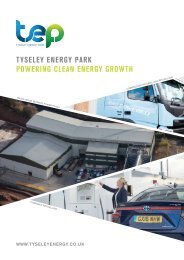connected-clusters-report-energy
Clustering innovation to create thriving and prosperous low-carbon cities and regions
Clustering innovation to create thriving and prosperous low-carbon cities and regions
You also want an ePaper? Increase the reach of your titles
YUMPU automatically turns print PDFs into web optimized ePapers that Google loves.
University of Birmingham | Climate-KIC 51<br />
Identity plays a double role in cluster<br />
development. On the one hand, it can be<br />
used as a visioning tool to help galvanise those<br />
within the cluster towards a common mission.<br />
The creation of a brand under which regional<br />
activity can be united is a useful device to allow<br />
regions to construct their identities and stories<br />
of industrial transformation. These stories<br />
can be used to capture buy-in from actors<br />
inside the region and focus them on<br />
climate-friendly goals.<br />
Identity is also key to the way that <strong>clusters</strong><br />
present themselves to the outside world and<br />
to cluster growth. Once critical mass has been<br />
attained, cluster growth is sustained by its<br />
ability to draw in new members. The cluster’s<br />
identity affects how it markets itself, either to<br />
potential start-ups and SMEs or to political<br />
actors and industry. This affects the quantity,<br />
calibre and scale of actors attracted.<br />
Managing Incumbents and Insurgents<br />
Clusters face a significant challenge<br />
around managing co-existing firms on different<br />
scales. They will often be home to large<br />
anchor firms as well as smaller start-ups and<br />
new SMEs. There is a challenge in managing<br />
the sometimes-conflicting priorities of firms at<br />
different scales. For climate innovation <strong>clusters</strong>,<br />
successfully disrupting the status quo to<br />
encourage the transition to cleaner alternatives<br />
is also key.<br />
There is an enduring tension in the innovation<br />
space between large firms and smaller<br />
newcomers. Whilst new firms may have new<br />
ideas and novel thinking, they may not have<br />
the resources to bring an idea to market.<br />
However, they are smaller, more agile and may<br />
be able to develop solutions more quickly than<br />
established players. With fewer resources,<br />
smaller entrants must find innovative ways to<br />
develop ‘lean’ solutions that do not impose<br />
a high overhead on scarce resources.<br />
By contrast, larger firms may be more set in<br />
their ways. They have brands to defend, and<br />
large amounts of sunk assets invested in<br />
certain products, processes and services<br />
– so may be slower to change. That said,<br />
by virtue of their size and scale, they have<br />
the potential to have substantial impact if<br />
they change direction. Whilst they have the<br />
resource to develop solutions, their capacity<br />
to change is often limited by hierarchy,<br />
structure and organisational inertia.<br />
The Frankfurt cluster is an interesting example<br />
of these tensions in the positioning of the<br />
cluster as an innovator in circular economy<br />
solutions, within a cluster of industrial partners<br />
with a long tradition of the production of<br />
chemicals whose processes might not be<br />
readily adapted.<br />
Trends and technologies change quickly.<br />
Globally, there are <strong>clusters</strong> that are littered<br />
with the remains of firms that did not manage<br />
to innovate quickly enough. Kodak missed<br />
the digital camera revolution, and Nokia didn’t<br />
manage to capture the smartphone market<br />
quickly enough. However, for every failed<br />
leviathan, there are thousands more small<br />
ventures that did not make it to market.




